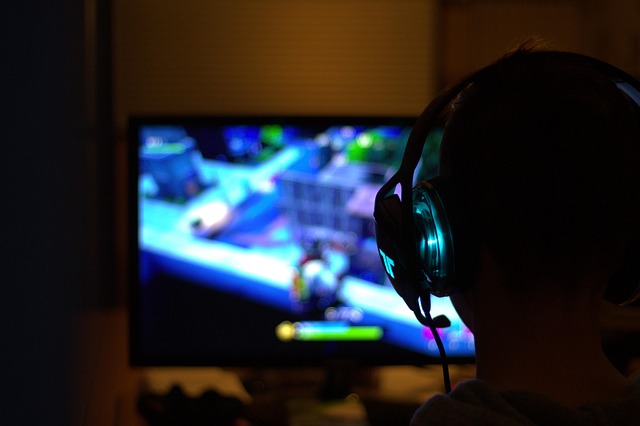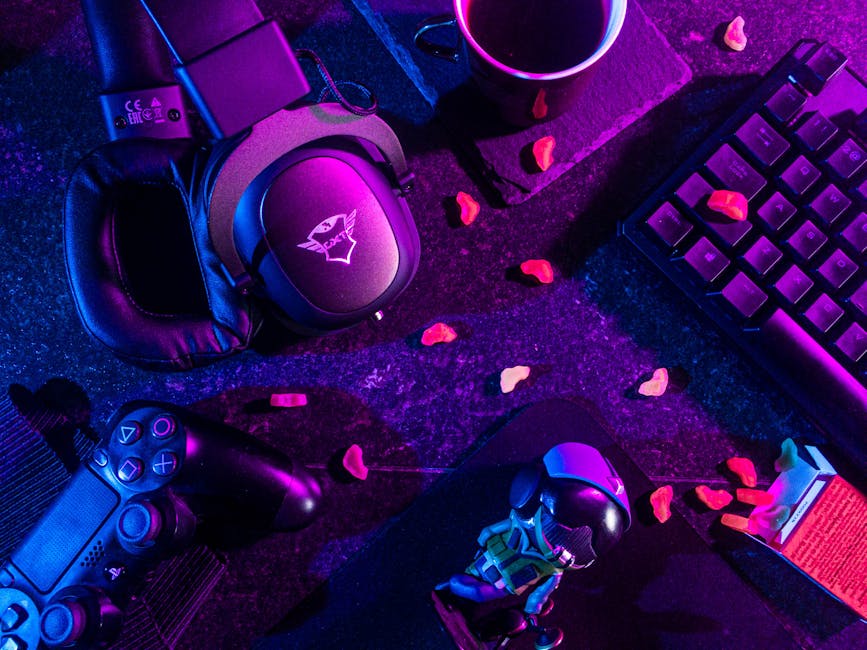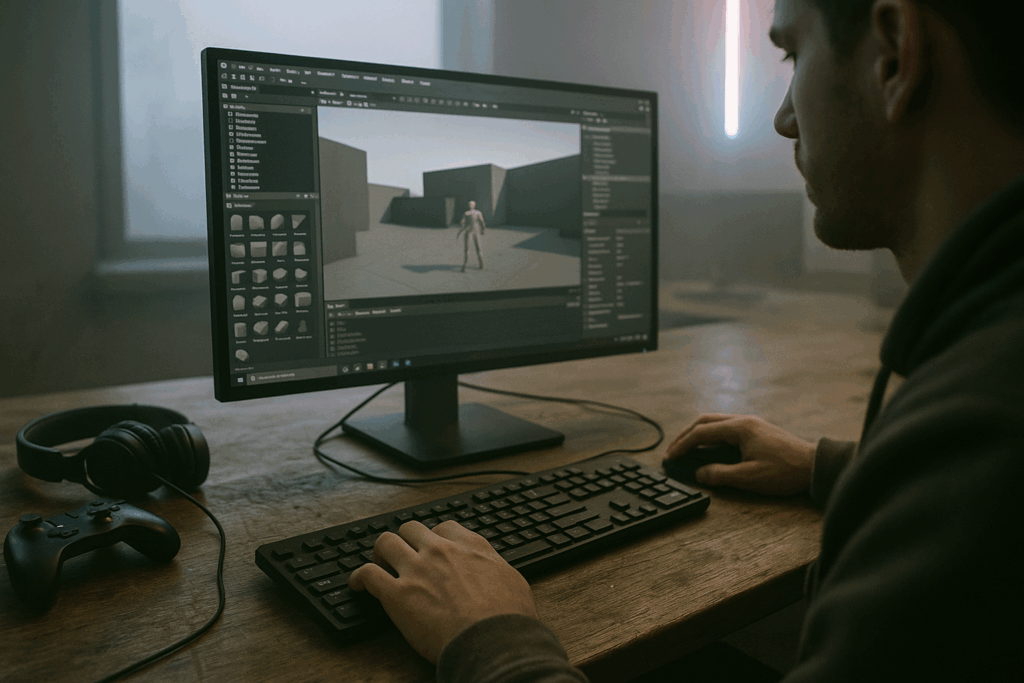Start with Your Space
Setting up a powerful gaming rig is only part of the equation. Before you plug in a single cable, you need to optimize your physical setup. The foundation of any great gaming experience starts with your space.
Desk Size and Layout Basics
Your desk forms the central hub of your gaming station, and its size and layout directly impact comfort and organization. Don’t underestimate these basics:
- Choose a desk size that accommodates your monitor(s), keyboard, mouse, and other peripherals without feeling cramped.
- Consider surface depth so you can position your monitor at a comfortable distance (about an arm’s length away).
- Plan for layout—is your setup in a corner, against a wall, or part of a multipurpose room? This will influence your cable paths and lighting.
Lighting: Functional First, Aesthetic Second
Lighting isn’t just about looks—it affects visibility, focus, and eye strain.
- Prioritize diffuse task lighting to reduce glare on your screen.
- Use adjustable LED desk lamps for flexibility during late-night sessions.
- Explore ambient lighting such as smart bulbs or light strips that enhance mood without overpowering the space.
Tame the Cable Chaos
Cable management is often overlooked, but it makes a major difference in daily use and long-term maintenance.
- Use cable trays or raceways under the desk to hide power strips and wires.
- Velcro ties and clips help keep your cables tight and organized.
- Label your cables for easier swapping and troubleshooting in the future.
A tidy setup not only looks cleaner—it helps you focus and prevents accidental unplugging during intense gameplay.
Create a Distraction-Free Zone
Your gaming space should support immersion and focus:
- Position your desk in a low-traffic area to reduce interruptions.
- Face away from windows or distractions to stay in the zone.
- Use noise-dampening materials (like rugs, curtains, or foam panels) if you share your space.
The goal is simple: build a space that enhances your gameplay, not one you constantly fight against.
PC vs. Console Setup: What Suits Your Style and Goals
Start by being honest with yourself—are you here for competitive edge or chill sessions after work? A console setup is simpler, cheaper, and takes up less space. It’s plug-and-play, and perfect if your focus is casual gaming or you prefer couch comfort. But if customization, modding, multitasking, or streaming are on your radar, PC is the move. It has a higher skill ceiling but gives back in versatility.
Now let’s talk CPU, GPU, and RAM. Don’t just chase top-tier specs. What actually matters is balance. A high-end GPU won’t save you if your CPU bottlenecks. Likewise, 64GB of RAM doesn’t help much if your GPU is five years old. Aim for current mid-to-high gear that works together. Future-proof by looking at titles you want to play, not just spec charts.
On the monitor front, skip the trap of going ultra-premium without reason. You don’t need 4K and 240Hz unless you’re both a visual snob and a pro-level esports grinder. For most, 1080p at 144Hz or 1440p at 75Hz is the sweet spot. Prioritize refresh rate over max resolution if you play fast-paced titles. You want fluid motion, not pixel bragging rights.
Peripherals That Make the Difference
Your gear is only as good as the tools you use to control it. Start with your keyboard. Mechanical keyboards offer tactile feedback, faster response, and durability that membrane setups just can’t match. But they can be loud, and not everyone wants that click-clack under pressure. Membrane keyboards are quieter and often cheaper. If you’re into casual gaming or don’t want to wake the neighbors, they might work. Still, for serious play and feel, mechanical wins hands down.
Next, your mouse. Don’t just buy based on DPI numbers. Shape, grip, and weight matter more in actual game sessions than most specs. Some gamers swear by ultra-light mice for quick flicks in shooters. Others prefer a heavier setup for precision in strategy or sim games. Find one that rests comfortably in your hand and doesn’t fight your muscle memory. Bonus points if it has on-the-fly DPI switching and customizable buttons.
Finally, don’t sleep on your headset. You want clear surround audio to track footsteps and movement—yes. But also, your mic should offer clean, crisp input without picking up keyboard abuse or your breath. A good headset with solid mic monitoring eliminates the need for a separate mic in casual streams or team chat. Wireless is fine, but check latency before committing.
These peripherals shape how you perform and how connected you feel during gameplay. Choose them like your K/D depends on it—because it probably does.
Comfort is Critical
If you’re gaming for hours, comfort isn’t optional—it’s survival. Start with the chair. An ergonomic chair isn’t just a luxury; it’s the foundation. It supports your back, aligns your posture, and keeps you focused. Buy the cheap seat now, regret it when your spine starts complaining. A solid investment here pays off in joints and energy.
Next, look at your monitor and keyboard setup. Your screen should be at eye level—no craning your neck like a turtle. Your keyboard and mouse? Keep them low enough so your elbows stay relaxed but not cramped. Think forearms parallel to the floor.
And yes, wrist rests and foot support matter. Skip them, and you’ll slowly grind your way into wrist pain and lower back fatigue. A simple wrist cushion or footrest can be a game-changer, especially during long sessions or streams. Small tweaks here prevent big problems later.
Internet and Streaming Gear
A strong setup doesn’t matter if your connection drags. For online gaming, 25 Mbps download and 5 Mbps upload is bare minimum—but let’s be honest, that’s struggling. Aim for at least 100 Mbps down and 20 Mbps up if you’re gaming and uploading content. More if you’re sharing bandwidth or streaming in 1080p or higher. Ping matters more than speed—low latency keeps your gameplay smooth and reactive.
Still using the router your provider gave you? Probably time to upgrade. A mid-range router with Wi-Fi 6 support reduces lag and handles multiple devices without choking. Ethernet is king for gaming—run a LAN cable if possible. It’s stable, fast, and won’t drop out mid-match.
Thinking about streaming? Your webcam doesn’t need to be cinematic—1080p at 30fps is fine. But lighting matters. A cheap ring light does more for clarity than a pricey camera in bad light. Voice-wise, ditch flimsy headset mics. A USB condenser mic like the Blue Yeti or Elgato Wave does the job—plug, play, sound pro.
Personalize Without Overdoing It
Too much RGB turns your setup from sleek to circus real fast. The glow should enhance, not overwhelm. If your desk looks like a crashed spaceship, dial it back. Use RGB intentionally—keyboard backlighting, a few soft-lit fans, maybe an accent panel behind your display. Less is cleaner, and clean looks pro.
Instead of covering every inch in LEDs, swap in some personality. Wall art, floating shelves, and a couple of themed decorations (think: framed game art, figurines, or soft lighting signs) tell a story without shouting. It’s your space—make it yours, not a showroom clone.
And don’t sleep on ambient lighting. A well-placed strip behind your monitor or under your desk shifts the vibe completely. It adds atmosphere, kills glare, and doesn’t punch your eyeballs like a string of rainbow Christmas lights. Mood matters—build a space that feels good to sit in for hours.
Keep the look simple, focused, and tuned to your taste. Style should support performance—not compete with it.
Budget vs. Performance: Smart Upgrades
If you’re building a gaming setup from scratch, or even just upgrading, it’s easy to overspend early. Don’t. The smartest setups are built in phases, with priorities sorted. Here’s what to invest in and what can wait.
First, splurge on your GPU. It’s the real workhorse, and will impact your experience more than anything else—frame rate, render times, even how future-proof your build is. Second, a solid monitor is worth it. Prioritize high refresh rate and good color accuracy. Everything looks better and plays smoother. And finally, don’t skimp on your chair. Unsexy as it sounds, comfort is non-negotiable when you’re logging serious hours. Your back will thank you.
Where to save? Desk accessories, decorative pieces, and smaller extras like USB fans or RGB clutter. They’re easy to add later and don’t impact gameplay or performance. A simple, functional setup trumps one that’s flashy but uncomfortable or underpowered.
Pace yourself. Build slow. Upgrade when it makes sense, not just when your feed tells you to. You’ll end up with a rig that actually fits your style, rather than one that drains your wallet out of impulse.
Gaming Communities & Support
Stay Connected to Evolve
The gaming world evolves fast—new updates, patches, and meta shifts happen almost daily. Staying active in online communities helps you keep pace and stay informed. Here’s where to plug in:
- Discord servers: Whether it’s general gaming or game-specific groups, Discord is where real-time discussions, tips, and announcements live.
- Reddit & forums: Subreddits and specialized forums offer threads on everything from hardware tweaks to gameplay strategies.
- YouTube & Twitch chat: Many streamers cultivate strong communities willing to offer feedback, share setup ideas, or dive into new tech.
More Than Social — It’s Strategic
Game communities aren’t just for conversation; they can actively help improve your experience and performance.
- Get feedback on your setup, game clips, or technical questions
- Discover new gear people swear by (and what to avoid)
- Collaborate with others for co-op play or streaming collaborations
Recommended Resource
For a deeper dive into which online groups provide the most value:
Read more: Joining the Best Gaming Communities for Support
Final Thoughts
Forget the hype. Building the ultimate gaming setup isn’t a race to squeeze in the most RGB or stack your rig with overpriced components. What actually matters is how smoothly everything works together. The feel of your chair during a long session. The angle of your monitor. The split-second responsiveness of your mouse or the warmth of ambient lighting that doesn’t leave your eyes fried.
Comfort is the foundation. Performance is the edge. Style is the bonus. Aim for a setup that fades into the background and lets your gameplay or stream take the spotlight.
And don’t treat your setup as static. Tech evolves, habits shift. Set a reminder every few months to reassess—maybe your keyboard angle needs tweaking, maybe your router deserves an upgrade, maybe that do-it-all chair doesn’t quite support your back anymore. Major changes aren’t always needed, but those small, intentional tweaks? They keep everything running smooth.




